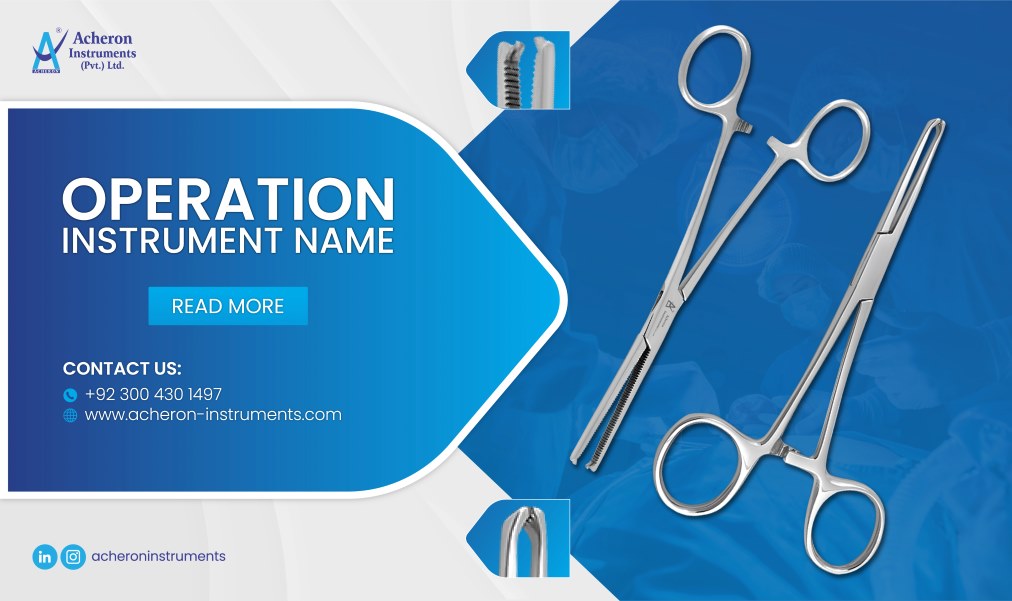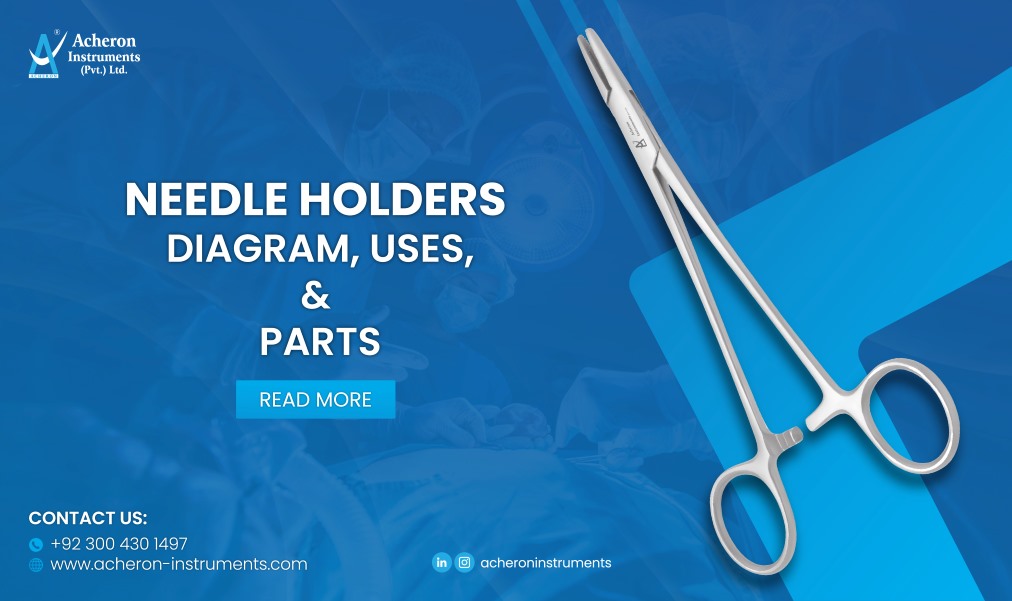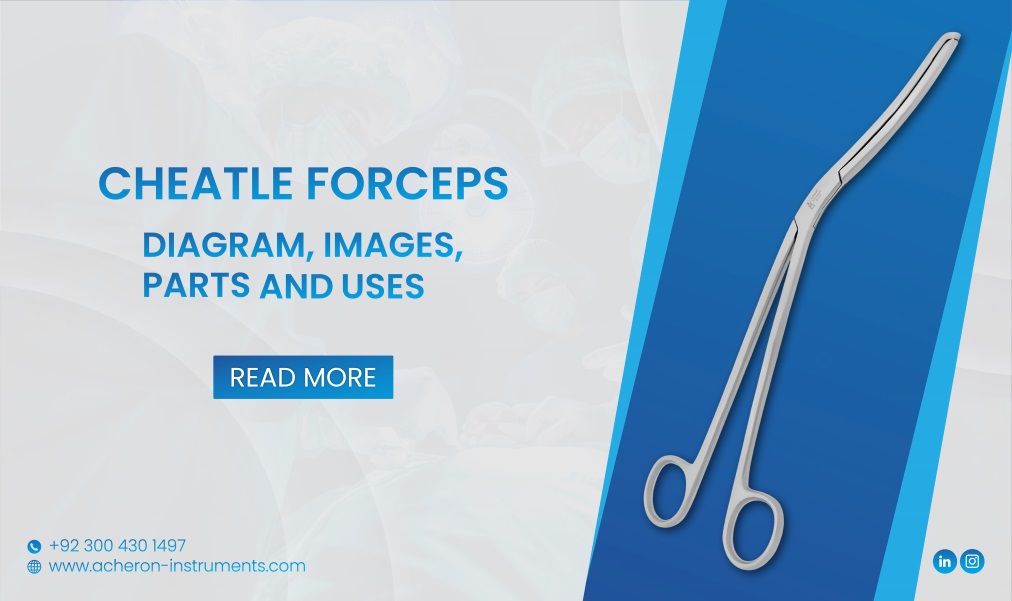In high-stakes environments of healthcare, the choice between forceps and hemostats can determine the success and complications of a procedure. Forceps are specialized for holding and grasping tissues or objects during surgical procedures featuring jaws, hinges, shanks, and ratchet mechanisms. In contrast, hemostats control bleeding and clamp blood vessels during surgical procedures featuring serrated jaws and ratchet mechanisms. Knowing their distinct role and functions is compulsory for the right choice of instrument and use. Let’s understand the key differences between forceps and hemostats:
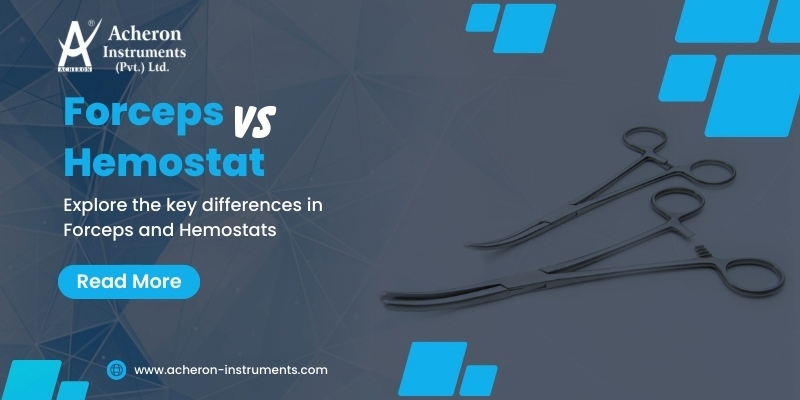
Forceps
Forceps are specialized tools for holding and grasping different tissues and objects during surgeries. When our fingers are too large, forceps are used to hold objects allowing hands to perform other tasks efficiently. Forceps vary in size and shape to serve a particular surgical need. Let’s explore some types of forceps:
Types of Forceps
Allis Tissue Forceps
Allis tissue forceps also known as hemostats serve multiple applications such as holding, gripping, manipulating tissues, and securing blood vessels. Allis forceps are suitable to be used during surgeries like gynecology, orthopedics, ENT, plastic, and reconstructive surgeries.
Allis forceps feature a self-retaining locking system with a ratchet locking system and, a secure grip with its broad tips and finger-ring handles.
Cheatle forceps
Cheatle forceps feature self-locking jaws to facilitate the grasping and manipulation of tissues during surgeries. Their lightweight design ensures surgeon’s fatigue-free performance leading to expected and successful outcomes. This instrument is useful for removing sterilized tools without infecting other tools from the surgical toolkit.
Artery Forceps
Artery forceps are designed to perform hemostasis (control bleeding) by occluding blood vessels during surgeries. They are designed with two looped scissors-like handles, a blunt nose, and a lock to ensure a tight grip on the vessel. Artery forceps include Burkitts’ Artery forceps, Right Angle Artery forceps, and Wilson Artery forceps.
Visit artery forceps vs needle holders to know more about artery forceps.
Babcock Forceps
Babcock forceps are atraumatic and non-perforating forceps specialized for grasping and holding delicate tissues during surgeries. They provide better control through their atraumatic serrations with streamlined design, especially in procedures like laparotomy and intestinal procedures. Before using them, learn about Babcock Forceps, Uses, Functionality and Importance.
Ovum Forceps
Ovum forceps feature a lightweight design with self-locking jaws to securely grasp the ovum during medical procedures. Its lightweight design reduces the fatigue of surgeons and helps them easily perform surgeries.
Sponge Holding Forceps
Sponge holding forceps are useful as they grasp, hold, and mobilize sponges and surgical dressings used during surgical procedures. Explore more about these forceps by visiting Sponge Holding Forceps, Uses, Functionality, and Benefits.
Dressing Forceps
Dressing forceps are handheld surgical instruments used for applying or removing dressings and removing infected tissues and debris from the wounds. They provide an atraumatic way to clean the surgical site and are used as an alternative to needle holders when not accessible. Acheron Instruments provides different dressings forceps according to one’s preference such as Adson Dressing forceps, thumb dressing forceps, and Tilleys Nasal Dressing forceps.
Let’s understand what are Hemostats and their role in surgical procedures.
Hemostats
Hemostat also known as artery forceps or hemostatic clamps are used to control bleeding and perform hemostasis during surgeries. Another use is to hold and secure the top layer of tissue while cleaning and removing dead tissue from the wound. They feature serrated jaws and a ratchet mechanism to maintain pressure and provide a clear surgical site.
Types of Hemostats
Let’s discover some types of Hemostats to understand them in detail:
Mosquito Hemostats
Mosquito Hemostats are small and delicate with fine tips useful for clamping blood vessels in precise surgeries. They are ideal for procedures like pediatric and delicate tissue procedures.
Kelly Hemostats
These hemostats are useful for clamping larger vessels and tissues in general surgical procedures. They are larger than mosquito forceps featuring serrated jaws on the tips only.
Crile Hemostats
Similar to Kelly hemostats but they have serrations running the full lengths of jaws. This design makes them effective for clamping medium to large blood vessels and tissues. They are suitable for procedures requiring a firm grip by offering a secure grip throughout the length of jaws.
Halsted Hemostats
Halsted hemostats are short with fine tips ideal for clamping blood vessels during surgeries like plastic or reconstructive procedures. They are specifically designed for tasks needing careful manipulation and gentle touch to avoid damage to surrounding tissues.
Key Differences
Purpose
Forceps
The purpose of forceps is to hold and grasp tissues allowing hands to perform other tasks efficiently.
Hemostats
The purpose of hemostats is to control bleeding and clamp blood vessels during surgeries to provide a clear surgical site.
Anatomy and Design
Forceps and hemostats may look similar but they are characterized by small differences. The serrated jaws of forceps provide a firm grip while hemostats are characterized by their locking mechanism and broader, blunt tips.
Forceps
Forceps come in various sizes and shapes tailored to the surgical need or purpose. The basic forceps design features a handle for a firm grip (straight or curved), a shaft, and working ends (jaws or tips).
Handles:
The handles of forceps that may be straight or curved are designed to provide comfortable grip and precision. They may also have finger loops for enhanced control and grip.
Shaft:
The shaft connects the handles to the working ends of the forceps. Its length can vary on the type and intended use of forceps allowing it to access deeper spaces.
Working Ends:
The working ends of forceps refer to parts that come in direct contact with the tissues and surgical site. Forceps have jaws or tips (flat, serrated, or toothed) depending on the type and intended use of forceps.
Hemostats
Hemostats may be curved or straight with serrated jaws for a firm grip on blood vessels. The basic hemostat design consists of finger loop handles, a shaft, the working end (jaws or tips), and the locking mechanism.
Handles:
Hemostats include handles that often finger-loops for finger and thumb placement, providing a secure and comfortable grip.
Shaft:
The shaft connects the handles to the working ends (jaws or tips) and varies in length according to the intended use.
Working Ends:
The working ends of hemostats are usually jaws or tips. The jaws are usually curved or straight, designed for clamping blood vessels while the tips are serrated or toothed. Jaws and tips ensure a secure grip without the risk of slipping.
Locking Mechanism:
Hemostats are equipped with a ratchet lock mechanism near the finger loops allowing the jaws to lock in place. They ensure consistent pressure by locking their jaws at various degrees of tightness.
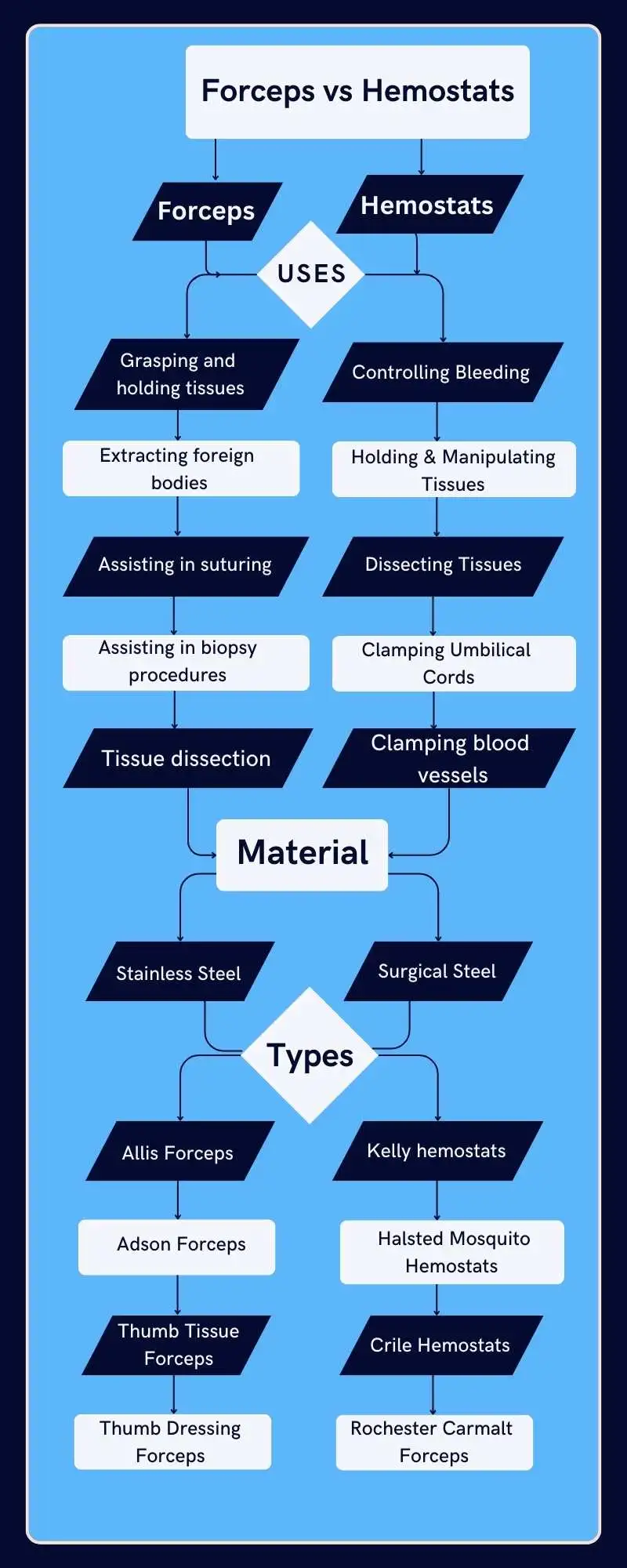
Primary Uses
Forceps and hemostats both are essential tools in medical procedures but they serve their distinct purposes. Let’s have a look at the uses of forceps and hemostats:
Forceps
- Forceps are used for holding objects or tissues during surgical procedures
- Handling delicate tissues or small objects and allowing the surgeon’s hands to perform other tasks
- Versatile tools for tissue manipulation, suturing, and other general surgery tasks
Hemostats
- Primarily used for clamping blood vessels and controlling bleeding during surgical procedures
- Applications in areas such as dentistry and veterinary medicine due to their diverse nature
- Hemostats excel at providing effective hemorrhage management during procedures.
Limitations
Although forceps and hemostats are very useful, they are not ideal for all situations. Each instrument has its benefits but some limitations. Let’s find out the limitations of forceps and hemostats:
Forceps
- Forceps may not provide sufficient traction for larger and tougher issues affecting the effectiveness
- Prolonged use can cause hand fatigue affecting precision and control
- Improper or excessive use of forceps may cause tissue damage and bruises to delicate tissues
- Forceps are specialized for specific purposes and not applicable for general use.
Hemostats
- Can cause tissue damage if not handled carefully.
- Available in various sizes but may not be suitable for all surgical needs
- Prolonged use can impact the precision and performance by causing hand fatigue
- The ratchet lock can wear out with time and may impact the precision and outcomes of procedures
Material
Forceps and hemostats are essential tools whose performance and durability depend on the material used in crafting them. The most commonly used materials for the construction of forceps and hemostats are stainless steel and surgical steel. Each material has its benefits and must be chosen according to the surgical need. Let’s have a quick analysis of the benefits of each material:
Stainless Steel:
Stainless steel is well-known for its durable and long-term nature which makes it an excellent choice for surgical instruments. Stainless steel provides the following benefits:
- Corrosion resistance: Stainless steel can resist rust or corrosion making the instruments durable.
- Cost-effective: Stainless steel provides manufacturers with a cost-effective and affordable option for the construction of surgical instruments.
- Ease in Sterilization: Stainless steel can withstand repeated sterilization without degrading ensuring long-term use.
Surgical Steel:
Surgical steel is a high-quality and bio-compatible variant of stainless steel that offers superior strength and durability. Surgical steel is chosen for the following reasons:
- Bio-Compatibility: Surgical steel ensures good tolerance reducing the risks of adverse reactions caused by the instruments.
- Corrosion resistance: Like stainless steel, surgical steel is also corrosion resistant ensuring longevity and durability.
- Strength and durability: Surgical steel is known for its strength and durability ensuring tolerance to frequent use and sterilization.
The choice of the material depends on the surgical need and specific requirements of the instrument. Both are a good option for crafting durable and long-term surgical instruments.
To explore more about stainless and surgical steel, visit our comprehensive article: Stainless Steel vs Surgical Steel.
Consideration Factors
Choosing a surgical instrument heavily impacts the success of a procedure. While choosing the right surgical instruments, it's necessary to examine the specific needs of the procedure. The following are some considerations that must be taken into account while choosing forceps or hemostats for a procedure:
- Specific Requirements of Procedure: It is necessary to know and understand the requirements for the procedure. Forceps will help in grasping and holding objects while hemostats will control bleeding. We have to decide whether forceps or hemostats will be enough or not.
- Cost and Resource Allocation: Balancing cost and resource allocation as well as strategic planning is necessary to avoid shortages and overstocking.
Conclusion
When it comes to choosing between forceps and hemostats, specific needs of the procedure must be taken into account. Moreover, one must be clear about the intended use of the instruments being used. Forceps and Hemostats are both necessary tools but for their intended purpose. Forceps are ideal for procedures that involve grasping tissues and organs although they may not be suitable for delicate procedures. In contrast, hemostats clamp blood vessels and control bleeding during procedures but cannot provide a firm grip like forceps. Therefore, before making a choice, knowing the specific requirements of a procedure is essential.


